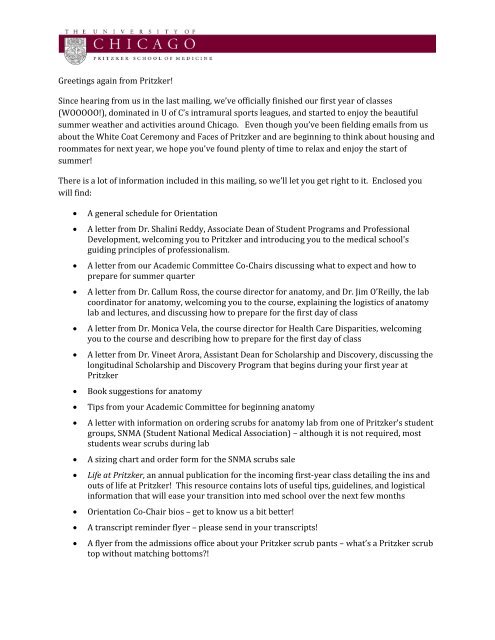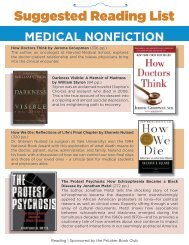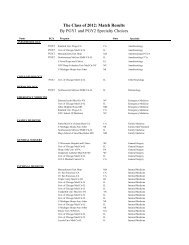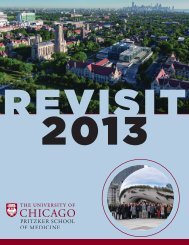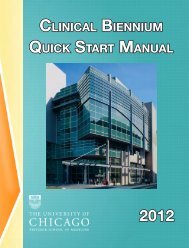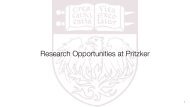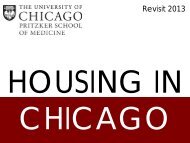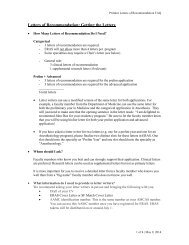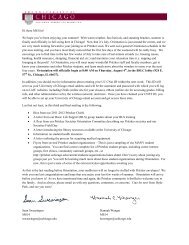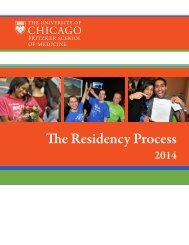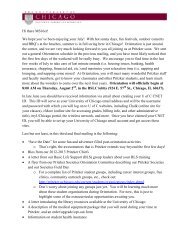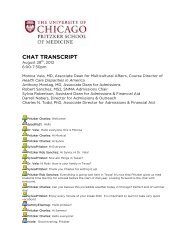Download - Pritzker School of Medicine - University of Chicago
Download - Pritzker School of Medicine - University of Chicago
Download - Pritzker School of Medicine - University of Chicago
Create successful ePaper yourself
Turn your PDF publications into a flip-book with our unique Google optimized e-Paper software.
Greetings again from <strong>Pritzker</strong>!<br />
Since hearing from us in the last mailing, we’ve <strong>of</strong>ficially finished our first year <strong>of</strong> classes<br />
(WOOOOO!), dominated in U <strong>of</strong> C’s intramural sports leagues, and started to enjoy the beautiful<br />
summer weather and activities around <strong>Chicago</strong>. Even though you’ve been fielding emails from us<br />
about the White Coat Ceremony and Faces <strong>of</strong> <strong>Pritzker</strong> and are beginning to think about housing and<br />
roommates for next year, we hope you’ve found plenty <strong>of</strong> time to relax and enjoy the start <strong>of</strong><br />
summer!<br />
There is a lot <strong>of</strong> information included in this mailing, so we’ll let you get right to it. Enclosed you<br />
will find:<br />
• A general schedule for Orientation<br />
• A letter from Dr. Shalini Reddy, Associate Dean <strong>of</strong> Student Programs and Pr<strong>of</strong>essional<br />
Development, welcoming you to <strong>Pritzker</strong> and introducing you to the medical school's<br />
guiding principles <strong>of</strong> pr<strong>of</strong>essionalism.<br />
• A letter from our Academic Committee Co-Chairs discussing what to expect and how to<br />
prepare for summer quarter<br />
• A letter from Dr. Callum Ross, the course director for anatomy, and Dr. Jim O’Reilly, the lab<br />
coordinator for anatomy, welcoming you to the course, explaining the logistics <strong>of</strong> anatomy<br />
lab and lectures, and discussing how to prepare for the first day <strong>of</strong> class<br />
• A letter from Dr. Monica Vela, the course director for Health Care Disparities, welcoming<br />
you to the course and describing how to prepare for the first day <strong>of</strong> class<br />
• A letter from Dr. Vineet Arora, Assistant Dean for Scholarship and Discovery, discussing the<br />
longitudinal Scholarship and Discovery Program that begins during your first year at<br />
<strong>Pritzker</strong><br />
• Book suggestions for anatomy<br />
• Tips from your Academic Committee for beginning anatomy<br />
• A letter with information on ordering scrubs for anatomy lab from one <strong>of</strong> <strong>Pritzker</strong>’s student<br />
groups, SNMA (Student National Medical Association) – although it is not required, most<br />
students wear scrubs during lab<br />
• A sizing chart and order form for the SNMA scrubs sale<br />
• Life at <strong>Pritzker</strong>, an annual publication for the incoming first-year class detailing the ins and<br />
outs <strong>of</strong> life at <strong>Pritzker</strong>! This resource contains lots <strong>of</strong> useful tips, guidelines, and logistical<br />
information that will ease your transition into med school over the next few months<br />
• Orientation Co-Chair bios – get to know us a bit better!<br />
• A transcript reminder flyer – please send in your transcripts!<br />
• A flyer from the admissions <strong>of</strong>fice about your <strong>Pritzker</strong> scrub pants – what’s a <strong>Pritzker</strong> scrub<br />
top without matching bottoms?!
Here are some deadlines to keep in mind:<br />
• White Coat Ceremony Survey due June 10 th – this date has already passed, so please submit<br />
your responses ASAP if you have not already done so:<br />
http://pritzker.bsd.uchicago.edu/current/students/orientation/eforms.shtml)<br />
• Faces <strong>of</strong> <strong>Pritzker</strong> Survey due June 24 th – this is a really quick, fun survey, so please take a<br />
moment to fill it out:<br />
http://pritzker.bsd.uchicago.edu/current/students/orientation/eforms.shtml)<br />
• Immunization Form due July 1 st – refer to the first mailing for information on immunization<br />
requirements; direct questions to Keeya Bailey at Keeya.Bailey@uchospitals.edu<br />
• SNMA Scrubs Order Form due July 10 th – this is optional; but if you do not get scrubs, please<br />
make sure you have some old clothes to use in lab that you won’t mind throwing away at<br />
the end <strong>of</strong> anatomy<br />
That’s all for now. As you await your final orientation mailing in July, please continue to check the<br />
Orientation website (http://pritzker.uchicago.edu/current/students/orientation/) and, most<br />
importantly, relax and enjoy your summer! In less than two months, you will be an <strong>of</strong>ficial <strong>Pritzker</strong><br />
medical student, and we are all looking forward to welcoming you to campus. As always, please<br />
contact us at orientation@bsd.uchicago.edu with any questions, comments, or concerns.<br />
Cheers,<br />
Sean Swearingen<br />
MS14<br />
Hannah Wenger<br />
MS14
General Orientation Schedule<br />
While we are still working out the details <strong>of</strong> the Orientation schedule, we wanted to<br />
give you some information on your *general* time commitments for the weekend.<br />
Thursday, August 4th, 2011<br />
8:00AM‐4:30PM—Orientation activities on campus<br />
5:30PM‐??—Orientation social activities, bonding time with your new classmates<br />
and members <strong>of</strong> MS14!<br />
Friday, August 5th, 2011<br />
8:00AM‐4:00PM—Orientation activities on campus<br />
Saturday, August 6th, 2011<br />
9:00AM‐12:00PM—Basic Life Support Testing<br />
1:00PM‐? – A social surprise<br />
Sunday, August 7 th , 2011<br />
3:00PM‐7:00PM – White Coat Ceremony<br />
Monday, August 8 th , 2011<br />
8:30AM‐1:00PM—Orientation activities on campus<br />
Tuesday August 9 th , 2011<br />
Classes Begin
Summer 2011<br />
Dear Students,<br />
We are excited that you will be joining the <strong>Pritzker</strong> family in August and I’d like to extend a<br />
warm personal welcome to all <strong>of</strong> you! In the weeks leading up to medical school, there will<br />
undoubtedly be times when you will be awed by, and perhaps nervous about, the notion that you<br />
will become a physician in a few short years. The foundation <strong>of</strong> knowledge and skills you will<br />
gain during your time at <strong>Pritzker</strong> will serve you well as you care for patients throughout your<br />
careers. You will ultimately become the type <strong>of</strong> physician you wrote about in your applications<br />
to medical school – someone who is compassionate, competent and pr<strong>of</strong>essional.<br />
The last word can be a difficult one to define. A few years ago, a group <strong>of</strong> students, faculty, staff<br />
and deans set out to define what pr<strong>of</strong>essionalism means to <strong>Pritzker</strong>. The group created a<br />
document outlining the guiding principles <strong>of</strong> pr<strong>of</strong>essionalism that will serve as a “touchstone”<br />
during medical school. We will talk about these principles throughout your time here at <strong>Pritzker</strong>.<br />
Our first discussion will be during orientation and I hope you will review the guiding principles<br />
in advance so we can engage in a rich and meaningful discussion.<br />
I look forward to meeting you all in August!<br />
With warm regards,<br />
Shalini Reddy MD<br />
Associate Dean <strong>of</strong> Student Programs and Pr<strong>of</strong>essional Development<br />
The <strong>University</strong> <strong>of</strong> <strong>Chicago</strong> <strong>Pritzker</strong> <strong>School</strong> <strong>of</strong> <strong>Medicine</strong><br />
Associate Pr<strong>of</strong>essor<br />
Department <strong>of</strong> Internal <strong>Medicine</strong>
The <strong>University</strong> <strong>of</strong> <strong>Chicago</strong> <strong>Pritzker</strong> <strong>School</strong> <strong>of</strong> <strong>Medicine</strong><br />
Guiding Principles <strong>of</strong> Pr<strong>of</strong>essionalism<br />
Pr<strong>of</strong>essional Responsibilities<br />
As a medical student and future physician, I have chosen to pursue a pr<strong>of</strong>ession which requires<br />
personal integrity, compassion, and a constant awareness <strong>of</strong> the commitment I have made to<br />
myself, to my patients, and to the other members <strong>of</strong> the teams with whom I work. Exhibiting<br />
personal behaviors consistent with a respect for my chosen pr<strong>of</strong>ession and having pride in my<br />
work are central tenets <strong>of</strong> pr<strong>of</strong>essionalism which I will strive to incorporate into my daily life. To<br />
demonstrate my commitment to these responsibilities while enrolled at the <strong>Pritzker</strong> <strong>School</strong> <strong>of</strong><br />
<strong>Medicine</strong>, I will:<br />
1. Seek and accept feedback and constructive instruction from teachers, peers, residents and<br />
faculty in order to continually improve my educational experience, knowledge, and<br />
clinical skills.<br />
2. Commit to the highest standards <strong>of</strong> competence both for myself and for those with whom<br />
I work.<br />
3. Recognize the importance <strong>of</strong> life-long learning and commit to maintaining competence<br />
throughout my medical career.<br />
4. Be mindful <strong>of</strong> my demeanor, language, and appearance in the classroom, in the presence<br />
<strong>of</strong> patients, and in all health care settings.<br />
5. Be accountable to all members <strong>of</strong> the <strong>Pritzker</strong> community, including students, residents,<br />
faculty, and support staff.<br />
6. Admit to and assume responsibility for mistakes in a mature and honest manner and<br />
develop productive strategies for correcting them.<br />
7. Refrain from using illicit substances. Refrain from using alcohol, non-prescription or<br />
prescription drugs in a manner that may compromise my judgment or my ability to<br />
contribute to safe and effective patient care.<br />
8. Be considerate and respectful <strong>of</strong> others’ (teachers, peers, residents and faculty) time,<br />
rights, values, religious, ethnic and socioeconomic backgrounds, lifestyles, opinions, and<br />
choices, even when they differ from my own.<br />
9. Meet the expectations for participation and timeliness that are communicated to me by<br />
those who teach me.<br />
10. Take an active role in caring for the diverse patient population served by the <strong>University</strong><br />
<strong>of</strong> <strong>Chicago</strong> Medical Center.<br />
11. Recognize my limitations and seek help when my expertise, knowledge, or level <strong>of</strong><br />
experience is inadequate to handle a situation in the classroom, hospital, or research<br />
setting.
The <strong>University</strong> <strong>of</strong> <strong>Chicago</strong> <strong>Pritzker</strong> <strong>School</strong> <strong>of</strong> <strong>Medicine</strong><br />
Guiding Principles <strong>of</strong> Pr<strong>of</strong>essionalism<br />
Pr<strong>of</strong>essional Relationships<br />
Establishing productive and respectful relationships with patients, faculty, residents, staff, and<br />
colleagues is an essential component <strong>of</strong> providing the best possible health care. To strive for<br />
pr<strong>of</strong>essionalism and kindness in all <strong>of</strong> my daily encounters, I will:<br />
1. Maintain appropriate relationships with patients, teachers, peers, residents and faculty.<br />
2. Treat all members <strong>of</strong> the <strong>University</strong> <strong>of</strong> <strong>Chicago</strong> Medical Center and <strong>Pritzker</strong> community,<br />
patients, and their families with respect, compassion, and dignity.<br />
3. Be mindful to avoid intentionally embarrassing or deriding others.<br />
4. Provide feedback to others (both colleagues and superiors) in a constructive manner, with<br />
the goal <strong>of</strong> helping them to improve.<br />
5. Treat those who participate in my education (e.g. standardized patients) with dignity and<br />
respect.<br />
6. Actively work to create an atmosphere in classrooms, clinical settings and in laboratories<br />
that is conducive to optimal, interactive learning.<br />
7. Help and support my peers during difficult times in their academic, pr<strong>of</strong>essional, and<br />
personal lives.<br />
8. Attend to my own physical and emotional well-being.
The <strong>University</strong> <strong>of</strong> <strong>Chicago</strong> <strong>Pritzker</strong> <strong>School</strong> <strong>of</strong> <strong>Medicine</strong><br />
Guiding Principles <strong>of</strong> Pr<strong>of</strong>essionalism<br />
Pr<strong>of</strong>essional Ethic<br />
Certain personal values and behaviors will be expected <strong>of</strong> me as a care-giver and as an<br />
ambassador <strong>of</strong> the <strong>Pritzker</strong> <strong>School</strong> <strong>of</strong> <strong>Medicine</strong>. Through my behaviors, I will demonstrate a<br />
commitment to honoring and upholding the expectations <strong>of</strong> the medical pr<strong>of</strong>ession, and, in so<br />
doing, I will contribute to maintaining society’s trust in it. In particular, I will:<br />
1. Maintain the highest standards <strong>of</strong> academic and scholarly honesty throughout my medical<br />
education, by behaving in a trustworthy manner.<br />
2. Recognize and function in a manner consistent with my role as a student on a team.<br />
3. Maintain a commitment to patient confidentiality, recognizing that patients will trust me<br />
with sensitive information.<br />
4. Place my patients’ interests and well-being at the center <strong>of</strong> my educational and<br />
pr<strong>of</strong>essional behavior and goals.<br />
5. Treat cadaveric and other scientific specimens with respect.<br />
6. Adhere to the standards <strong>of</strong> the pr<strong>of</strong>ession as put forth by the American Board <strong>of</strong> Internal<br />
<strong>Medicine</strong> Physician Charter (Appendix A) whose fundamental principles are social<br />
justice, patient autonomy, and the primacy <strong>of</strong> patient welfare.<br />
7. Learn about and avoid conflicts <strong>of</strong> interest as I carry out my responsibilities.<br />
8. Contribute to medical knowledge through active scholarship and discovery.
Appendix A: Medical Pr<strong>of</strong>essionalism in the New Millennium A New Charter ABIM<br />
2004 ABIM Foundation, ACP Foundation, European Federation <strong>of</strong> Internal <strong>Medicine</strong><br />
Preamble<br />
Pr<strong>of</strong>essionalism is the basis <strong>of</strong> medicine’s contract with society. It demands placing the interests <strong>of</strong> patients above those <strong>of</strong><br />
the physician, setting and maintaining standards <strong>of</strong> competence and integrity, and providing expert advice to society on matters<br />
<strong>of</strong> health. The principles and responsibilities <strong>of</strong> medical pr<strong>of</strong>essionalism must be clearly understood by both the pr<strong>of</strong>ession and<br />
society. Essential to this contract is public trust in physicians, which depends on the integrity <strong>of</strong> both individual physicians and<br />
the whole pr<strong>of</strong>ession.<br />
At present, the medical pr<strong>of</strong>ession is confronted by an explosion <strong>of</strong> technology, changing market forces, problems in health<br />
care delivery, bioterrorism, and globalization. As a result, physicians find it increasingly difficult to meet their responsibilities<br />
to patients and society. In these circumstances, reaffirming the fundamental and universal principles and values <strong>of</strong> medical<br />
pr<strong>of</strong>essionalism, which remain ideals to be pursued by all physicians, becomes all the more important. The medical pr<strong>of</strong>ession<br />
everywhere is embedded in diverse cultures and national traditions, but its members share the role <strong>of</strong> the healer, which has<br />
roots extending back to Hippocrates. Indeed, the medical pr<strong>of</strong>ession must contend with complicated political, legal, and market<br />
forces. Moreover, there are wide variations in medical delivery and practice through which any general principles may be<br />
expressed in both complex and subtle ways. Despite these differences, common themes emerge and form the basis <strong>of</strong> this<br />
charter in the form <strong>of</strong> three fundamental principles and as a set <strong>of</strong> definitive pr<strong>of</strong>essional responsibilities.<br />
Fundamental Principles<br />
Principle <strong>of</strong> primacy <strong>of</strong> patient welfare. The principle is based on a dedication to serving the interest <strong>of</strong> the patient. Altruism<br />
contributes to the trust that is central to the physician-patient relationship. Market forces, societal pressures, and administrative<br />
exigencies must not compromise this principle.<br />
Principle <strong>of</strong> patient autonomy. Physicians must have respect for patient autonomy. Physicians must be honest with their<br />
patients and empower them to make informed decisions about their treatment. Patients’ decisions about their care must be<br />
paramount, as long as those decisions are in keeping with ethical practice and do not lead to demands for inappropriate care.<br />
Principle <strong>of</strong> social justice. The medical pr<strong>of</strong>ession must promote justice in the health care system, including the fair<br />
distribution <strong>of</strong> health care resources. Physicians should work actively to eliminate discrimination in health care, whether based<br />
on race, gender, socioeconomic status, ethnicity, religion, or any other social category.<br />
A Set <strong>of</strong> Pr<strong>of</strong>essional Responsibilities<br />
Commitment to pr<strong>of</strong>essional competence. Physicians must be committed to lifelong learning and be responsible for<br />
maintaining the medical knowledge and clinical and team skills necessary for the provision <strong>of</strong> quality care. More broadly, the<br />
pr<strong>of</strong>ession as a whole must strive to see that all <strong>of</strong> its members are competent and must ensure that appropriate mechanisms are<br />
available for physicians to accomplish this goal.<br />
Commitment to honesty with patients. Physicians must ensure that patients are completely and honestly informed before the<br />
patient has consented to treatment and after treatment has occurred. This expectation does not mean that patients should be<br />
involved in every minute decision about medical care; rather, they must be empowered to decide on the course <strong>of</strong> therapy.<br />
Physicians should also acknowledge that in health care, medical errors that injure patients do sometimes occur. Whenever<br />
patients are injured as a consequence <strong>of</strong> medical care, patients should be informed promptly because failure to do so seriously<br />
compromises patient and societal trust. Reporting and analyzing medical mistakes provide the basis for appropriate prevention<br />
and improvement strategies and for appropriate compensation to injured parties.<br />
Commitment to patient confidentiality. Earning the trust and confidence <strong>of</strong> patients requires that appropriate confidentiality<br />
safeguards be applied to disclosure <strong>of</strong> patient information. This commitment extends to discussions with persons acting on a<br />
patient’s behalf when obtaining the patient’s own consent is not feasible. Fulfilling the commitment to confidentiality is more<br />
pressing now than ever before, given the widespread use <strong>of</strong> electronic information systems for compiling patient data and an<br />
increasing availability <strong>of</strong> genetic information. Physicians recognize, however, that their commitment to patient confidentiality<br />
must occasionally yield to overriding considerations in the public interest (for example, when patients endanger others).<br />
Commitment to maintaining appropriate relations with patients. Given the inherent vulnerability and dependency <strong>of</strong><br />
patients, certain relationships between physicians and patients must be avoided. In particular, physicians should never exploit<br />
patients for any sexual advantage, personal financial gain, or other private purpose.
Appendix A: Medical Pr<strong>of</strong>essionalism in the New Millennium A New Charter ABIM<br />
2004 ABIM Foundation, ACP Foundation, European Federation <strong>of</strong> Internal <strong>Medicine</strong><br />
Commitment to improving quality <strong>of</strong> care. Physicians must be dedicated to continuous improvement in the quality <strong>of</strong> health<br />
care. This commitment entails not only maintaining clinical competence but also working collaboratively with other<br />
pr<strong>of</strong>essionals to reduce medical error, increase patient safety, minimize overuse <strong>of</strong> health care resources, and optimize the<br />
outcomes <strong>of</strong> care. Physicians must actively participate in the development <strong>of</strong> better measures <strong>of</strong> quality <strong>of</strong> care and the<br />
application <strong>of</strong> quality measures to assess routinely the performance <strong>of</strong> all individuals, institutions, and systems responsible for<br />
health care delivery. Physicians, both individually and through their pr<strong>of</strong>essional associations, must take responsibility for<br />
assisting in the creation and implementation <strong>of</strong> mechanisms designed to encourage continuous improvement in the quality <strong>of</strong><br />
care.<br />
Commitment to improving access to care. Medical pr<strong>of</strong>essionalism demands that the objective <strong>of</strong> all health care systems be<br />
the availability <strong>of</strong> a uniform and adequate standard <strong>of</strong> care. Physicians must individually and collectively strive to reduce<br />
barriers to equitable health care. Within each system, the physician should work to eliminate barriers to access based on<br />
education, laws, finances, geography, and social discrimination. A commitment to equity entails the promotion <strong>of</strong> public health<br />
and preventive medicine, as well as public advocacy on the part <strong>of</strong> each physician, without concern for the self-interest <strong>of</strong> the<br />
physician or the pr<strong>of</strong>ession.<br />
Commitment to a just distribution <strong>of</strong> finite resources. While meeting the needs <strong>of</strong> individual patients, physicians are<br />
required to provide health care that is based on the wise and cost-effective management <strong>of</strong> limited clinical resources. They<br />
should be committed to working with other physicians, hospitals, and payers to develop guidelines for cost effective care. The<br />
physician’s pr<strong>of</strong>essional responsibility for appropriate allocation <strong>of</strong> resources requires scrupulous avoidance <strong>of</strong> superfluous<br />
tests and procedures. The provision <strong>of</strong> unnecessary services not only exposes one’s patients to avoidable harm and expense but<br />
also diminishes the resources available for others.<br />
Commitment to scientific knowledge. Much <strong>of</strong> medicine’s contract with society is based on the integrity and appropriate use<br />
<strong>of</strong> scientific knowledge and technology. Physicians have a duty to uphold scientific standards, to promote research, and to<br />
create new knowledge and ensure its appropriate use. The pr<strong>of</strong>ession is responsible for the integrity <strong>of</strong> this knowledge, which is<br />
based on scientific evidence and physician experience.<br />
Commitment to maintaining trust by managing conflicts <strong>of</strong> interest. Medical pr<strong>of</strong>essionals and their organizations have<br />
many opportunities to compromise their pr<strong>of</strong>essional responsibilities by pursuing private gain or personal advantage. Such<br />
compromises are especially threatening in the pursuit <strong>of</strong> personal or organizational interactions with for-pr<strong>of</strong>it industries,<br />
including medical equipment manufacturers, insurance companies, and pharmaceutical firms. Physicians have an obligation to<br />
recognize, disclose to the general public, and deal with conflicts <strong>of</strong> interest that arise in the course <strong>of</strong> their pr<strong>of</strong>essional duties<br />
and activities. Relationships between industry and opinion leaders should be disclosed, especially when the latter determine the<br />
criteria for conducting and reporting clinical trials, writing editorials or therapeutic guidelines, or serving as editors <strong>of</strong> scientific<br />
journals.<br />
Commitment to pr<strong>of</strong>essional responsibilities. As members <strong>of</strong> a pr<strong>of</strong>ession, physicians are expected to work collaboratively<br />
to maximize patient care, be respectful <strong>of</strong> one another, and participate in the processes <strong>of</strong> self regulation, including remediation<br />
and discipline <strong>of</strong> members who have failed to meet pr<strong>of</strong>essional standards. The pr<strong>of</strong>ession should also define and organize the<br />
educational and standard-setting process for current and future members. Physicians have both individual and collective<br />
obligations to participate in these processes. These obligations include engaging in internal assessment and accepting external<br />
scrutiny <strong>of</strong> all aspects <strong>of</strong> their pr<strong>of</strong>essional performance.<br />
Summary<br />
The practice <strong>of</strong> medicine in the modern era is beset with unprecedented challenges in virtually all cultures and societies. These<br />
challenges center on increasing disparities among the legitimate needs <strong>of</strong> patients, the available resources to meet those needs,<br />
the increasing dependence on market forces to transform health care systems, and the temptation for physicians to forsake their<br />
traditional commitment to the primacy <strong>of</strong> patients’ interests. To maintain the fidelity <strong>of</strong> medicine’s social contract during this<br />
turbulent time, we believe that physicians must reaffirm their active dedication to the principles <strong>of</strong> pr<strong>of</strong>essionalism, which<br />
entails not only their personal commitment to the welfare <strong>of</strong> their patients but also collective efforts to improve the health care<br />
system for the welfare <strong>of</strong> society. This Charter on Medical Pr<strong>of</strong>essionalism is intended to encourage such dedication and to<br />
promote an action agenda for the pr<strong>of</strong>ession <strong>of</strong> medicine that is universal in scope and purpose.
Hello MS15s!! June 10, 2011<br />
Welcome to <strong>Pritzker</strong> and congratulations on the beginning <strong>of</strong> your medical career.<br />
As your Academic Orientation Co-chairs we’re here to help you navigate the <strong>Pritzker</strong> curriculum<br />
and put you in touch with the resources you’ll need to be successful. Each quarter is different<br />
and we hope to provide resources to help you transition between courses. At the beginning <strong>of</strong><br />
each quarter, we’ll provide a booklist with feedback from previous students about the<br />
resources they found most useful. We’ll also provide an overview <strong>of</strong> what to expect from<br />
upcoming classes and give you the opportunity to ask questions.<br />
During orientation you’ll meet Dr. Brukner, the Associate Dean <strong>of</strong> Medical Education. She’ll<br />
provide an overview <strong>of</strong> the <strong>Pritzker</strong> Initiative and how the curriculum is designed to guide you<br />
on your road to becoming a physician. In addition you’ll have the opportunity to ask second<br />
year students questions about The Human Body course. We’ll also provide some general advice<br />
about what to expect about academics during the first year at <strong>Pritzker</strong>.<br />
In this packet there are materials to introduce you to summer classes. Attached you’ll find a<br />
letter from Dr. Monica Vela, the course director <strong>of</strong> Health Care Disparities in America, and Dr.<br />
Vineet Arora, the course director <strong>of</strong> Scholarship and Discovery. You’ll also find a letter from The<br />
Human Body course director, Dr. Callum Ross.<br />
We’ve included a list <strong>of</strong> required and recommended texts for anatomy. The <strong>of</strong>ficial course<br />
books include: Gray’s Anatomy for Students, Grant’s Dissector, The Developing Human (by<br />
Moore and Persaud), and Human Sectional Anatomy Pocket Atlas <strong>of</strong> Body Sections, CT and MRI<br />
images. However, many students choose to buy alternate texts that better suit their study<br />
preferences. Please see the enclosed list <strong>of</strong> book ratings and take the time to check out the<br />
comments for each book to get a feel for what our classmates—the Class <strong>of</strong> 2014—found to be<br />
most helpful. When reading these comments keep in mind that everyone has his or her unique<br />
learning style; different books appeal to different people. You’ll also find a handout on tips and<br />
tricks for getting through anatomy lab and anatomy lecture.<br />
The Anatomy course is fast-paced, but well organized. Due to the accelerated sequence, it may<br />
help if you begin familiarizing yourself with some important terminology before arriving on<br />
campus. Dr. Ross suggests taking a look at the embryology book by Moore and Persaud to<br />
make your first week easier. This text will be useful throughout the entire anatomy course as<br />
each unit begins with development and embryology. If you are willing to wait to purchase your<br />
books, we will be holding a book sale during orientation August where you can purchase many<br />
<strong>of</strong> the texts listed above (at a much reduced price).<br />
Now for a few words about the Anatomy course. First, the course will be time intensive, so<br />
take time to relax and enjoy your summer—there will be plenty <strong>of</strong> time for studying once you<br />
start med school.
Second, human dissection can be difficult for some students; <strong>of</strong>ten books or open discussion<br />
with your friends and family can help you prepare for many feelings encountered during your<br />
time in the gross lab. Before the first day <strong>of</strong> dissection, Dr. Farr Curlin will give a lecture on<br />
humanism in medicine and address many issues surrounding the gross lab. If you have<br />
concerns or questions about dissection, please feel free to contact Dr. Curlin whose email<br />
address is included at the bottom <strong>of</strong> this letter.<br />
Third, the <strong>University</strong> <strong>of</strong> <strong>Chicago</strong> web site for Anatomy will be made available to you as soon as<br />
possible. It is located at on the Chalk system: chalk.uchicago.edu. All <strong>of</strong> the lectures from last<br />
year will be posted and updated as class nears. The human embryology material will be<br />
available for download from this site as well. To log in, you’ll need to activate your CNet ID; you<br />
should receive e-mail notification when this occurs. Once you’ve activated your CNet ID, you<br />
should also be able to access TimeSpace (http://kakashi.uchicago.edu/timespace/), where you<br />
can access recordings and powerpoints from courses given in the 2010-2011 school year,<br />
including Anatomy.<br />
Fourth, contained in this mailing is information for purchasing scrubs through SNMA. Some<br />
students choose this route, but there will also be used scrubs available from last year’s class.<br />
While we can’t guarantee the number <strong>of</strong> used scrubs available, there were more than enough<br />
to go around for students who wanted them last year. Scrubs are not absolutely necessary, you<br />
can wear whatever you like as long as you don’t mind throwing it away. Please bring a pair <strong>of</strong><br />
shoes that you can also throw away at the end <strong>of</strong> lab. See the included list <strong>of</strong> “tips” for further<br />
information on how to prepare for anatomy lab.<br />
We hope this provides a preview <strong>of</strong> summer quarter and the year to come. Please email us<br />
with any questions or concerns regarding academics or the curriculum. If you have any<br />
questions or concerns about the anatomy course please contact us, Dr. Ross, or Dr. O’Reilly. If<br />
you have concerns about human dissection, please contact Dr. Kieff or Dr. Curlin.<br />
Enjoy your summer and see you in August,<br />
Cassie LaMar<br />
clamar@uchicago.edu<br />
Kim Clinite<br />
kclinite@uchicago.edu<br />
Teaching Staff Information<br />
Dr. Ross, Anatomy Course Director<br />
rossc@uchicago.edu<br />
Dr. Curlin, Humanism in <strong>Medicine</strong><br />
fcurlin@medicine.bsd.uchicago.edu<br />
Dr. O’Reilly, Anatomy Lab Instructor/Lecturer<br />
oreilly@uchicago.edu<br />
Dr. Kieff, Assistant Dean for Student Affairs<br />
ekieff@bsd.uchicago.edu
May 31, 2011<br />
DEPARTMENT OF ORGANISMAL BIOLOGY AND ANATOMY<br />
1027 East 57th Street <strong>Chicago</strong>, IL 60637<br />
Ross Phone: 773 834 7858<br />
rossc@uchicago.edu<br />
Dear 2011 Entering Class,<br />
As Course Director, I welcome you to The Human Body, the human gross anatomy course at the<br />
<strong>Pritzker</strong> <strong>School</strong> <strong>of</strong> <strong>Medicine</strong>. During this course you will learn a large new anatomical vocabulary,<br />
learn to identify a large number <strong>of</strong> structures in a cadaver and ultimately be able to visualize the<br />
three dimensional relationships <strong>of</strong> those structures to one another in your patients.<br />
Most <strong>of</strong> you are looking ahead to the upcoming course with a mixture <strong>of</strong> great anticipation and at<br />
least some trepidation. Beyond the obvious issues around death and the dissection <strong>of</strong> a human<br />
body, you should know that the experience <strong>of</strong> cadaver dissection will pr<strong>of</strong>oundly change how you<br />
view yourself and others. It is an essential first step in your education as a clinician, but it is also<br />
an experience that will set you apart from most other people.<br />
Know that your instructors are keenly aware <strong>of</strong> some <strong>of</strong> the intense emotions you may experience<br />
when you initially work with your cadaver, but try to keep in mind that those difficult emotions<br />
will pass. The temporary discomfort you may experience is well worth it, as a good working<br />
knowledge <strong>of</strong> anatomy is essential to be effective in most areas <strong>of</strong> medicine. If you are worried<br />
about your initial reaction to working in the cadaver lab, you may contact me<br />
(rossc@uchicago.edu), or Dr. Elizabeth Kieff, Department <strong>of</strong> Psychiatry and Behavioral<br />
Neurobiology, Assistant Dean for Student Affairs (ekieff@bsd.uchicago.edu ). Dr. Kieff is a great<br />
resource available to you for addressing issues surrounding death and dissection. If it would help,<br />
you may also decide to contact Dr. O’Reilly, (oreilly@uchicago.edu) and arrange for a private tour<br />
before the cadaver laboratories start.<br />
Teaching Staff<br />
I will be joined in the laboratory and lecture hall by our outstanding teaching staff: Dr. O’Reilly,<br />
Laboratory Coordinator and Senior Lecturer in OBA, and postdoctoral teaching fellows, Dr. Jose<br />
Iriarte-Diaz (http://home.uchicago.edu/~jiriarte/) and Dr. Laura Porro<br />
(http://strainlab.uchicago.edu/Members/laura-porro/laura-porro). Dr. Iriarte-Diaz (“Pepe”) is<br />
originally from Chile and earned his Ph.D. from Brown <strong>University</strong>. Dr. Porro is originally from<br />
<strong>Chicago</strong>, and earned her Ph.D. at Cambridge <strong>University</strong> in the U.K. They are all exceptional<br />
anatomists, as well as dedicated and popular teachers. This year Dr. O’Reilly was awarded the<br />
LDH Wood Preclerkship Teaching Award by the first year medical students! I look forward to<br />
working with these people again.<br />
In addition to your laboratory instructors, you will benefit greatly from the attention <strong>of</strong> our student<br />
teaching assistants. The student TAs are mainly second and fourth year medical students, but can<br />
also include M.D./Ph.D. students and graduate students. Many <strong>of</strong> these TAs have served as TAs in<br />
1
the past. They are carefully selected and play a critical role in the course. TAs will actively assist<br />
you in your dissections, conduct regular small group sessions on medical imaging, conduct review<br />
sessions with the cadavers and organize practice practical exams. The TAs work incredibly hard<br />
for you and deserve your utmost respect and gratitude.<br />
Throughout the course, we will be visited in lab by clinicians from the hospital. They will provide<br />
a short clinical lecture at the beginning <strong>of</strong> lab and then will tour the lab and visit with you while<br />
you are dissecting. They are <strong>of</strong>ten accompanied by some <strong>of</strong> their residents. These clinical lectures<br />
give you some clinical context for the anatomy you are learning, but also give you chance to meet<br />
potential future mentors and to make contacts with people you might like to shadow.<br />
Laboratories<br />
The laboratory portion <strong>of</strong> the Human Body course is very technical. The goal is for you to learn<br />
anatomy so that you can understand and converse readily with your future clinical instructors. The<br />
course is not an intellectual exercise and the material covered is carefully chosen to provide the<br />
level <strong>of</strong> detail you need to progress efficiently in subsequent clinical courses. Of course, you may<br />
ultimately choose a specialty that requires knowledge <strong>of</strong> only specific subset <strong>of</strong> the material we<br />
will cover – but at this point, many <strong>of</strong> you are intellectual stem cells, and your fate is<br />
undetermined. What you learn in this course will allow you to pursue any pr<strong>of</strong>essional path, and<br />
perhaps more importantly, help you make informed decisions about your pr<strong>of</strong>essional future.<br />
The material covered in lectures will be revisited in the laboratory portion <strong>of</strong> the course. The<br />
laboratory portion <strong>of</strong> the course is very structured and very dense. Attendance in lab is required,<br />
for several reasons. You are unlikely to pass the course if you do not attend. The scheduled<br />
laboratory times are the times when instructors, TAs and clinicians will be there. Moreover, during<br />
the ten weeks <strong>of</strong> the course, you and the other three members <strong>of</strong> your lab team will dissect an<br />
entire cadaver. This is an enormous amount <strong>of</strong> work and it is unreasonable, unfair and<br />
unpr<strong>of</strong>essional for you to expect the other members <strong>of</strong> your team to do this work for you. So, be<br />
prepared, show up on time, and do your fair share <strong>of</strong> the work. Plan your life accordingly. In<br />
addition, you should expect to work outside <strong>of</strong> regular lab times in order to keep up with the<br />
dissection schedule. Indeed, you may find that you learn some things better in a small group, with<br />
a partner, or alone in lab.<br />
Dissection tools, manuals and atlases will be provided for each dissection team – these should<br />
never leave the lab. We do recommend that you buy a copy <strong>of</strong> the dissector and an atlas <strong>of</strong> your<br />
choice to prepare for lab and study for exams. You will need to have a set <strong>of</strong> dedicated clothing<br />
for working in the dissection lab. The chemicals used to preserve the cadavers are safe but<br />
odiferous – and you will not want to take those odors home with you. Locker rooms are provided<br />
for you to change in and out <strong>of</strong> your street clothing. We also have a limited supply <strong>of</strong> clean preowned<br />
scrubs that are available on a first-come, first-serve basis.<br />
The embryology labs in the first week will involve study <strong>of</strong> digital images <strong>of</strong> serially section<br />
human embryological material from the Carnegie Collection. The digital files and copies <strong>of</strong> the<br />
laboratory handouts will be available on the class website.<br />
2
We have purchased licenses for an interactive digital anatomy atlas that we will be using in lecture<br />
and lab - http://www.interactelsevier.com. Every class member will be able to install this on a<br />
computer. This s<strong>of</strong>tware only runs on a Windows operating system. If you do not have Windows,<br />
you can use the s<strong>of</strong>tware on a computer on campus. We are currently testing its compatibility with<br />
Windows emulator s<strong>of</strong>tware and will contact you when those tests are complete.<br />
Medical Imaging and Serial Sections<br />
Once you have learned your vocabulary and can identify structures <strong>of</strong> interest on a dissected<br />
cadaver, you need to be able to visualize these structures in place in three dimensions. This final<br />
step is achieved through the study <strong>of</strong> serial cross sections <strong>of</strong> intact cadavers and various types <strong>of</strong><br />
medical images taken from living patients (radiographs, MRI and CT scans). This material has<br />
been integrated into the course under the guidance <strong>of</strong> Dr. Chris Straus, in the Department <strong>of</strong><br />
Radiology. The original cross sections will be available for study in the anatomy lab, and images<br />
<strong>of</strong> the cross-sections are also available on the class website.<br />
Practical Exams<br />
Each written lecture exam is accompanied by a laboratory practical exam that is graded separately.<br />
The laboratory practical for the embryology module will consist <strong>of</strong> a PowerPoint presentation with<br />
questions about the same images from the Carnegie collection that are used in the laboratory. The<br />
material covered in the rest <strong>of</strong> the laboratories will be tested on cadavers, cross sections and<br />
medical images. Like the written exams, you must earn a grade <strong>of</strong> 65% in order to pass. You will<br />
have one chance to retake each exam if you fail on your first attempt.<br />
Study Tips<br />
Learning anatomy involves a great deal <strong>of</strong> memorization. The sooner you start to study the<br />
vocabulary, the better. So, if you want a leg up, get a set <strong>of</strong> flashcards and spend some quality time<br />
with them over the rest <strong>of</strong> the summer. An extremely effective strategy, and efficient use <strong>of</strong> your<br />
time, is to use the text and flashcards to become familiar with the names <strong>of</strong> the structures you will<br />
be looking for in your dissection BEFORE each lab. This allows you to focus on doing a good<br />
dissection and correctly identifying the various structures you need to know on the cadaver while<br />
in lab. It also allows you to utilize your TAs and instructors for learning the most challenging<br />
material rather than basic things you can learn on your own. You can also prepare for lab by<br />
viewing the dissection videos on the course website.<br />
I am looking forward to meeting all <strong>of</strong> you. Please feel free to e-mail me or Dr. O’Reilly if you<br />
have any questions.<br />
Sincerely,<br />
Callum F. Ross, Ph.D.<br />
Associate Pr<strong>of</strong>essor<br />
3
June 1, 2011<br />
Dear Students,<br />
I am looking forward to your arrival on campus and to working closely with you in the<br />
first couple <strong>of</strong> months.<br />
A few years ago, the Robert Wood Johnson Foundation awarded an $8 million grant to<br />
the <strong>University</strong> <strong>of</strong> <strong>Chicago</strong> and National Opinion Research Center to become the National<br />
Program Office for a major initiative called Finding Answers: Disparities Research for<br />
Change. Led by Marshall Chin, MD, MPH, Associate Pr<strong>of</strong>essor <strong>of</strong> <strong>Medicine</strong>, over 25<br />
faculty and staff across the <strong>University</strong> are the vanguard for this national effort housed on<br />
our campus in the Center for Health and the Social Sciences (CHeSS). The goals <strong>of</strong><br />
Finding Answers are to discover and evaluate interventions to reduce racial and ethnic<br />
health care disparities, disseminate the findings nationally and translate them into realworld<br />
practice.<br />
As a major component <strong>of</strong> this important initiative, <strong>Pritzker</strong> students attend Health<br />
Disparities in America, an intensive six-week course experience alongside the Anatomy<br />
coursework. The course draws upon the skills and strengths <strong>of</strong> instructors from a variety<br />
<strong>of</strong> different educational backgrounds, levels <strong>of</strong> training, and perspectives, including<br />
senior medical students, residents, fellows and faculty. The course utilizes an innovative<br />
and dynamic approach to help students attain a solid knowledge base in this field,<br />
including historical perspectives and current conditions. The curriculum has a special<br />
focus on the local surrounding communities and neighborhoods <strong>of</strong> the South Side <strong>of</strong><br />
<strong>Chicago</strong>. The goal is to arm you with the knowledge and skills that will help frame your<br />
medical education within the context <strong>of</strong> greater societal issues, provide access to mentors<br />
in the field <strong>of</strong> health disparities, create a basis for future service and research projects in<br />
health disparities, and, ultimately, support the development <strong>of</strong> you and your classmates<br />
into the future leaders who will effect real-world change. You will learn about the<br />
impactful changes our students have already made on our patients’ lives.<br />
There are no required texts for this course. The syllabus will contain a number <strong>of</strong> reading<br />
materials that will be available on the first day <strong>of</strong> classes. Previous classes <strong>of</strong> <strong>Pritzker</strong><br />
students have passed on a summer reading list that may help prepare you to for the<br />
complicated societal, health and health care issues addressed in the course. I have added<br />
this list to the end <strong>of</strong> this letter. This is by no means a required reading list. I do not<br />
recommend that you purchase these books. Rather, I would recommend that you visit a<br />
local library or borrow a used book.<br />
Previous students have had the following comments at the end <strong>of</strong> the course,<br />
“The mood among my classmates was optimistic, that we, in our limited time at <strong>Pritzker</strong>,<br />
could effect change and help the people around us.”
One <strong>of</strong> the best things…was how relevant…[the course was] to the specific neighborhood<br />
that we now live in and will serve,” “..the ties to the local community really focused us<br />
on the issues our patients will face..,” “..an important learning experience for me was<br />
learning more about the South Side <strong>of</strong> <strong>Chicago</strong>, especially the poverty in the area.”<br />
Congratulations to you on your success and best wishes to you as you pursue your goals<br />
in medicine.<br />
Sincerely,<br />
Monica Vela, M.D.<br />
Associate Pr<strong>of</strong>essor<br />
Course Director, Health Disparities in America<br />
Associate Vice Chair for Diversity<br />
Department <strong>of</strong> <strong>Medicine</strong><br />
Associate Dean <strong>of</strong> Multicultural Affairs<br />
<strong>University</strong> <strong>of</strong> <strong>Chicago</strong> <strong>Pritzker</strong> <strong>School</strong> <strong>of</strong> <strong>Medicine</strong><br />
Heat Wave: A Social Autopsy <strong>of</strong> Disaster in <strong>Chicago</strong> by Eric Klinenberg<br />
Mama Might Be Better Off Dead: The Failure <strong>of</strong> Health Care in Urban America by<br />
Laurie Kaye Abraham<br />
The Spirit Catches You and You Fall Down by Anne Fadiman<br />
Infections and Inequality by Paul Farmer<br />
Medical Apartheid by Harriet A. Washington
THE UNIVERSITY OF<br />
CHICAGO<br />
BIOLOGICAL SCIENCES<br />
D EPARTMENT OF M EDICINE<br />
Section <strong>of</strong> General Internal <strong>Medicine</strong><br />
5841 South Maryland Avenue, MC 2007, <strong>Chicago</strong>, Illinois 60637<br />
Phone 773-702-8157 • Fax 773-834-2238<br />
varora@medicine.bsd.uchicago.edu<br />
Dear incoming class <strong>of</strong> 2015,<br />
Welcome to <strong>Pritzker</strong> <strong>School</strong> <strong>of</strong> <strong>Medicine</strong> from Scholarship & Discovery! We have just<br />
completed our second year <strong>of</strong> this new program and are eager to build on our early<br />
successes. The Scholarship & Discovery team will be on hand in mid August to introduce<br />
you to the basic concepts <strong>of</strong> scholarship, the core knowledge related to the scholarly tracks<br />
(scientific investigation, quality and safety, medical education, global health, community<br />
health), the program milestones for each year, and <strong>of</strong> course our student successes with our<br />
faculty mentors.<br />
While the goal <strong>of</strong> scholarship & discovery program is ultimately to focus on a specific area<br />
and complete a mentored scholarly project before you graduate, that is 4 long years away.<br />
The first step on this journey is to ‘discover’ your interests. While some <strong>of</strong> you may arrive<br />
with predefined interests based on your college or post-college experiences, many <strong>of</strong> you<br />
will also be uncertain and ready to engage in new experiences to ultimately help inform your<br />
interests. In fact, we anticipate that you will likely engage in a variety <strong>of</strong> activities in your first<br />
year that will inform your choice <strong>of</strong> a mentor and track. For example, you may want to<br />
volunteer at one <strong>of</strong> several student free clinics, arrange an out <strong>of</strong> country healthcare<br />
experience, start a quality improvement project, TA a course, or conduct bench or clinical<br />
research. Formal ‘class’ time learning about scholarship does not compare to really getting<br />
out there and participating in these activities to figure out what you are ultimately interested<br />
in.<br />
So for the moment, relax and enjoy! We look forward to meeting you as you start this<br />
journey. Since part <strong>of</strong> discovery is self-learning, we have created Scholarship & Discovery<br />
wiki website to keep you posted <strong>of</strong> the latest in Scholarship & Discovery<br />
https://sites.google.com/site/scholarshipdiscovery<br />
If you have any questions that we can help you with, feel free to email us at<br />
scholarshipanddiscovery@bsd.uchicago.edu<br />
Warmest regards from the Scholarship and Discovery team,<br />
Sujata Mehta, MA<br />
Manager, Scholarship and Discovery<br />
<strong>Pritzker</strong> <strong>School</strong> <strong>of</strong> <strong>Medicine</strong>,<br />
<strong>University</strong> <strong>of</strong> <strong>Chicago</strong><br />
Vineet Arora, MD, MAPP<br />
Assistant Dean for Scholarship & Discovery<br />
<strong>Pritzker</strong> <strong>School</strong> <strong>of</strong> <strong>Medicine</strong>,<br />
<strong>University</strong> <strong>of</strong> <strong>Chicago</strong>
Summer 2011 Book List for Human Morphology and Anatomy<br />
Welcome MS15!<br />
We hope that you are getting excited to start medical school at <strong>Pritzker</strong> this August! This guide is<br />
designed to help you determine the books you might want to get for your upcoming summer <strong>of</strong><br />
anatomy. Because we already love you so much, MS14 has provided some advice on textbooks. For<br />
each book listed below, there are some statistics obtained about each book as well as some<br />
recommendations about them from our class. We have included only specific recommendations in<br />
order to more accurately guide you towards making a decision on which books to purchase. The<br />
textbook data were compiled from a survey completed by 69 students in our class.<br />
Notice that the required textbooks were not always judged the most useful. Still, take all this with a<br />
grain <strong>of</strong> salt: what matters most is that you find the resources that will work best for you, your study<br />
habits, and your budget.<br />
If you have any questions, feel free to pester:<br />
Cassandra Lamar (Academic co-chair) – clamar0510@gmail.com<br />
Kim Clinite (Academic co-chair) – kimberlina281@gmail.com<br />
Note: Underlined books are required.<br />
Gray’s Anatomy for Students:<br />
A user-friendly format, a regional organization, clear<br />
illustrations and photos make this book the go-to book for<br />
anatomy. Unique coverage <strong>of</strong> surface anatomy, correlative<br />
diagnostic images, and clinical case studies demonstrate practical<br />
applications <strong>of</strong> anatomical concepts.<br />
74% <strong>of</strong> students used this book<br />
The Good: “I loved Gray's Anatomy for Students and read<br />
the entire thing. It was extremely helpful to do this. Once I<br />
had the anatomy down, I only had to spend about an hour on radiology for each exam.”<br />
“For the written portion, Dr. Ross’ lectures and ppt's are all you need. I occasionally referenced<br />
Gray's for some <strong>of</strong> the harder concepts. For the practicals, the TA review sessions and the<br />
practice practicals before each test are absolutely key.”<br />
“Read Gray's Anatomy cover to cover. Reviewed the lectures and bold terms in the dissector<br />
and was good to go.”<br />
The Bad: “For the first two exams, I spent almost all <strong>of</strong> my time reading the assigned sections<br />
from Gray's anatomy and passed. However, I then stopped reading the text entirely and<br />
performed far better by focusing my attention on the powerpoints and flashcards.”
Grant’s Dissector:<br />
The step-by-step guide to cadaver dissection that we’ll be using in<br />
lab.<br />
23% bought this book and read it to prepare for lab or tests<br />
48% bought this book but did not use it<br />
29% did not buy this book<br />
The Good: “I wish I would have bought the dissector just<br />
because it’s such a short, easy read and it would have better<br />
prepared me for lab each day.”<br />
“None <strong>of</strong> the texts are really necessary, in my opinion, but if any, I'd get an Atlas and maybe<br />
Grant's.”<br />
The Bad: “I found that I could learn everything I needed to know from Dr. Ross' (and the other<br />
lecturers') lecture powerpoints.”<br />
Atlas <strong>of</strong> Human Anatomy (AKA Netter’s):<br />
49% <strong>of</strong> students used this book<br />
The Good: “Netter's Atlas is golden!”<br />
“Before each test, I always went over Gray's and/or Netter's,”<br />
The Bad: “I only used Grant's dissector and Netter's atlas in lab<br />
(the copies that were provided for use in lab).”<br />
Color Atlas <strong>of</strong> Anatomy (AKA Rohen’s):<br />
This atlas includes full-color photographs <strong>of</strong> actual cadaver dissections<br />
(instead <strong>of</strong> idealized illustrations) to accurately and realistically represent<br />
anatomical structures. Structures are numbered and labeled for self-study.<br />
32% <strong>of</strong> students used this book<br />
The Good: “Rohen's is great for reviewing before exams if you don't want to<br />
spend extra time in the lab after dark.”<br />
The Bad: There were no specific negative comments made about this<br />
textbook.
Netter’s Anatomy Flash Cards:<br />
Each card features a full-color illustration on the front, while<br />
concise text on the back reviews anatomical relevance and details<br />
as well as<br />
clinical correlations, where appropriate.<br />
.<br />
70% <strong>of</strong> students used Netter’s flashcards<br />
The Good: “Looking back, the most useful tools were the Netter's flashcards, lecture slides,<br />
and the info that TA's put on the whiteboards during lab.”<br />
“I performed far better by focusing my attention on the powerpoints and flashcards.”<br />
“I bought 2 sets <strong>of</strong> flashcards - Netter's and Gray's, and these were the key to passing.”<br />
“Flash cards, going to class/lab, and both atlases were the most helpful for me.”<br />
The Bad: There were no specific negative comments made about Netter’s flashcards.<br />
Developing Human Clinically Oriented Embryology<br />
(Moore & Persaud):<br />
This book on embryology and teratology describes each stage from<br />
conception to birth and details the development <strong>of</strong> various organs and<br />
systems. Particular attention is given to the emergence <strong>of</strong> birth defects.<br />
Note: Dr. Ross strongly recommends that you buy this book or borrow<br />
it from the library. It is the only book that really addresses<br />
development, and this topic comes up again and again and again.<br />
26% <strong>of</strong> students bought and read this book<br />
37% bought and referenced this book<br />
36% did not use this book<br />
The Good: “Embryology is just kind <strong>of</strong> inherently a little trickier to learn. Things twist and turn<br />
and do funky things we're not used to. It was nice to have some kind <strong>of</strong> stable reference.”<br />
“The book is really the only way to learn it all. You, however, only use the book for one week<br />
and very infrequently after that, so I would suggest checking it out from the library or getting a<br />
really cheap/old edition”<br />
“I did like having it around and thought it was a useful text. Do not let people tell you that you<br />
are done with embryology after the embryology unit -- embryology comes into play throughout<br />
the course!”
The Bad: “I didn't even open the embryology book, as most everyone told me would happen. It<br />
was really only a week's worth <strong>of</strong> material, and everything you need to know will be on the<br />
lecture slides.”<br />
And now for the new required Radiology textbook…<br />
Human Sectional Anatomy Pocket Atlas<br />
<strong>of</strong> Body Sections, CT and MRI images.<br />
3rd Ed. (2009)<br />
H. Ellis, B. Logan, and A. Dixon. Oxford <strong>University</strong> Press,<br />
Paperback, 288pp.<br />
ISBN13: 9780340985168ISBN10: 034098516X<br />
So by now, you are probably thinking: “Wow. There is<br />
so much to learn and so many resources to use. Why<br />
and how are we incorporating radiology into the<br />
anatomy course?”<br />
Radiology is important because it requires thinking about<br />
anatomic relationships in three dimensions and an ability to understand complex anatomy. This<br />
understanding reinforces one's knowledge <strong>of</strong> anatomy in a way that memorization can't and will be<br />
invaluable in the practical portion <strong>of</strong> the lab as well as a clinician. During the anatomy course,<br />
radiology will consist <strong>of</strong> 1-2 large lectures per module given by faculty <strong>of</strong> the radiology department.<br />
There will be daily small group lectures during lab time during which teaching assistants will go<br />
through the "core" images and explain the key points that will reinforce important radiologic<br />
concepts and anatomic structures. The students will be given a file <strong>of</strong> 30-50 "core" images from<br />
which a large portion <strong>of</strong> test questions will be directly taken. Students will also be given self study<br />
modules to work through in order to further their understanding <strong>of</strong> anatomy and spatial<br />
relationships. Each self study module will have practice questions that will reinforce core concepts<br />
and images from the "core" set. Each module will end with a radiology portion <strong>of</strong> the exam that will<br />
consist <strong>of</strong> 20 or so images. They will range from simply identifying structures on an image to<br />
complex tasks requiring the ability to arrange several images in correct anatomical order. The<br />
radiology portion will be a large portion <strong>of</strong> the practical grade (It counts for at least 20/70 points on<br />
the practical). This past year was the second time this book had been required.<br />
22% <strong>of</strong> people bought this book<br />
Here are some <strong>of</strong> the advantages/disadvantages <strong>of</strong> the textbook that the Radiology TAs and Dr.<br />
Straus would like you to be aware <strong>of</strong>:<br />
The Good: “The text has several images on each page that are comprehensively labeled.”<br />
The Bad: “Is Human Sectional Anatomy the radiology book? I was so mad that I bought it. What<br />
a worthless book. They should really take it <strong>of</strong>f the required materials list. I opened it once and<br />
immediately realized it would be completely useless to me.”
Some additional statistics on how people studied:<br />
The following is a list <strong>of</strong> methods people used to study and how frequently they used these<br />
methods<br />
• Flashcards<br />
o never used = 16.2%<br />
o on occasion = 35.3%<br />
o used frequently = 13.2%<br />
o for every exam = 35.3%<br />
• Did the assigned reading from the book<br />
o never used = 20.3%<br />
o on occasion = 39.1%<br />
o used frequently = 27.5%<br />
o for every exam = 13.0%<br />
• Made outlines from Lecture<br />
o never used = 32.4%<br />
o on occasion = 25.0%<br />
o used frequently = 23.5%<br />
o for every exam = 19.1%<br />
• Reviewed powerpoints and other materials<br />
o never used = 0%<br />
o on occasion = 2.9%<br />
o used frequently = 10.1%<br />
o for every exam = 87.0%<br />
Concluding remarks:<br />
We know that some <strong>of</strong> the advice in this guide conflicts – hey, everyone studies differently! – and<br />
that this document might worry you slightly about anatomy. But this guide is simply meant to<br />
convey MS14’s thoughts on the available anatomy books without freaking you out more. Please<br />
don’t freak out! You will all do wonderfully in anatomy. If you find that you still have concerns,<br />
please email the Academic Co-Chairs for more advice and guidance and feel free talk to any <strong>of</strong> the<br />
MS14ers about their book choices during Orientation! And remember…if you do end up buying too<br />
many books, you can always sell them to next year’s first-years .
Tips and Tricks to Get You Through Anatomy<br />
I. 11 Things To Know About Anatomy Lab<br />
1. Buy some scrubs for anatomy lab at the SNMA scrub sale: By now you all have a lovely<br />
<strong>Pritzker</strong> scrub top with the nice color and sewn logo. We highly recommend that you don’t use<br />
these scrubs for anatomy lab because trust us, you WILL throw out the scrubs that you use. The<br />
human body has a lot <strong>of</strong> unique substances and smells that accompany it and you will not want to<br />
keep your anatomy scrubs after the course is over, so you don’t want to use nice ones that will be<br />
fun to use later. Included in this packet you will find an order form for the SNMA scrub sale, and<br />
we highly recommend that you buy a set—the complete set is about $25. One set is fine but get 2 if<br />
you like to be extra clean or alternate while you wash one set.<br />
2. Use a pair <strong>of</strong> old sneakers that you won’t mind throwing out: Kind <strong>of</strong> like your scrubs, your<br />
shoes are going to be getting gross things on them that you won’t want to keep around. It’s also not<br />
really sanitary to wear shoes in the lab all the time and then track things out into the BSLC and<br />
outside world. Find an old pair <strong>of</strong> sneakers that you won’t mind throwing away or go to a cheap<br />
store and buy a pair if you don’t have any old shoes.<br />
Remember, fashion is NOT the issue—just get something sturdy that fits. NO OPEN<br />
TOES!!!! You need to wear socks and shoes to lab since we have sharp tools and human material<br />
around. Your shoes can be sneakers, no-holes crocs, etc.—just make sure they will keep yucky<br />
things from getting on your feet.<br />
3. Especially for the ladies: Ladies, bring an old bra or buy a cheap one and bring it the first day <strong>of</strong><br />
anatomy lab to leave in your locker. Even though you’ll have scrubs on, the smell goes through to<br />
your skin and clothes and you won’t want your expensive bra to start stinking! So buy one to leave<br />
in your locker so you can use it during lab and leave it there.<br />
4. Hair advice: If it pertains to you, find something to cover your hair—a bandana, a shower cap,<br />
whatever. The smell will get into your hair if it’s uncovered and it’s not easy to wash out plus it’s<br />
weird to “smell the lab” when you’re outside. A physical barrier to the smell is your best defense!<br />
Usually this is the best advice if you have longer hair but any hair picks up the smell so it’s up to<br />
you—plus, you have to get used to wearing caps for the OR anyway so it’s stylish, right? :o)<br />
5. Do not bring your copy <strong>of</strong> Grant’s dissector to lab: Copies will be provided for you in lab so<br />
you don’t have to get your copies all yucky like. You want to keep your copy nice for reading ahead<br />
at home!<br />
6. If you get cold easily, you may find the lab to be a cold place: A ratty long sleeve t-shirt or<br />
sweatshirt is just fine to wear under your scrub top. Just plan on throwing it out at the end!<br />
7. Don’t wear jewelry into the anatomy lab that’s on your hands/wrists: It gets in the way <strong>of</strong><br />
your gloves and you wouldn’t want to drop anything anywhere....<br />
8. All <strong>of</strong> your gloves and tools will be provided for you so don’t worry, you don’t have to buy<br />
any <strong>of</strong> that.
9. There are showers in the anatomy locker rooms so if you want to shower there, you can<br />
brings shower stuff for your locker although I would say that most people just went home to<br />
shower.<br />
10. Bring a plastic bag: If you want to protect your street clothes from the smell in the locker<br />
rooms, bring a plastic bag to put your things in while you’re in lab and then tie the bag before<br />
putting it in your locker. Like the hair tip, a physical barrier is the best smell defense.<br />
11. Have fun! Gross lab is a unique experience, and one you won’t necessarily ever have again – so<br />
make the most <strong>of</strong> it!<br />
II.<br />
Anatomy Lecture/Lab Study Tips<br />
1. Always, always, always do the old exams: Old exams are in the same format as the exams you<br />
will take. Some <strong>of</strong> the questions may also be recycled.<br />
2. For the most part, lectures and notes are sufficient to study from for exams. Don’t feel bad if<br />
you don’t read Grey’s from cover to cover. There may be some lectures where you will need to go<br />
to the book for the bulk <strong>of</strong> information but this is the exception and not the rule.<br />
3. Hit the ground running and keep up with the information. It’s easy to fall behind and tests are<br />
given very frequently.<br />
4. Identify organs and structures on different bodies. Organs in other bodies may have a slightly<br />
different appearance in other bodies, the more you are familiar with the different bodies the better<br />
prepared you will be for the test.<br />
5. Go to and/or set up the practice practicals. They give you a chance to show others the<br />
structures you know well as well as the chance for others to teach you structures you don’t know as<br />
well.<br />
6. For practicals, learn structures by relationships, knowing the general location <strong>of</strong> a structure<br />
and what structures are near it can help in situations where the answer may not be immediately clear.<br />
7. Don’t forget to study for the radiology portion <strong>of</strong> the exam! Learning radiology will help you<br />
learn the actual anatomy and vice versa. Don’t worry, you will master those CT and MRI images.<br />
8. Remember it’s P/F, work hard but don’t get too stressed .<br />
9. Make sure you check out the <strong>Pritzker</strong> Student Portal. The site has reviews, study notes, and old<br />
tests posted by former and current students. More information on how to access the portal during<br />
orientation<br />
10. There are much cheaper options than buying the books at the bookstore. Many <strong>of</strong> the<br />
books are available at the library either for two hour periods or entire quarters. Some editions <strong>of</strong><br />
books can also be read for free online. Upperclassmen also put their books up for sale during<br />
orientation and throughout the year. There will also be a used book sale held during orientation.
SCRUBS!<br />
Dear Class <strong>of</strong> 2015,<br />
The <strong>Pritzker</strong> Chapter <strong>of</strong> the Student National Medical Association (SNMA) is here to<br />
assist you with ordering scrubs for Gross Anatomy Lab! Scrubs also make for very<br />
comfortable pajamas and are a good gift for family and friends. Below you will find all<br />
the information that you need to order your<br />
scrubs.<br />
A) CHOOSE YOUR SCRUB STYLE:<br />
1. Sky Blue (no embroidery) (example right)<br />
-$25/set (V-neck Top and drawstring pants)<br />
2. Maroon with <strong>Pritzker</strong> <strong>School</strong> <strong>of</strong> <strong>Medicine</strong><br />
Logo<br />
embroidered on Top and Pants (see Stanford<br />
example right)<br />
-$30/set (V-neck Top and drawstring pants)<br />
B) FOR SIZING:<br />
-Please see the size chart (attached)<br />
C) TO PLACE YOUR ORDER:<br />
-Please E-mail the <strong>Pritzker</strong> SNMA chapter with the subject line “Scrubs” at<br />
pritzkerSNMA@yahoo.com with:<br />
-Your Name<br />
-Your Email Address<br />
-Size (No split sizes, please)<br />
-# <strong>of</strong> sets you want<br />
D) TO MAKE YOUR PAYMENT:<br />
-Please send a personal check (No cash, please) made out to “SNMA” to:<br />
SNMA c/o<br />
924 E. 57 th St., Suite 104<br />
<strong>Chicago</strong>, IL 60637<br />
ALL Orders and Money are due by July 10, and scrubs pick-up will be held during<br />
Orientation Week. Unfortunately, we cannot honor late orders. If you have any<br />
further questions about ordering scrubs, please feel free to email one <strong>of</strong> us below. Thank<br />
you, and welcome to <strong>Pritzker</strong>!<br />
Kunmi Sobowale, Treasurer<br />
U <strong>of</strong> C <strong>Pritzker</strong> Chapter SNMA<br />
ksobowale@gmail.com<br />
Kevin Stephens, President<br />
U <strong>of</strong> C <strong>Pritzker</strong> Chapter SNMA<br />
kevin.u.stephens@gmail.com
SNMA Annual Scrubs Sale Order Form<br />
Orders AND money must be received by July 10<br />
Orders can be e-mailed to pritzkerSNMA@yahoo.com “Scrubs” as the subject line<br />
You may e-mail the order form as a scanned document<br />
1-Pocket Plain Ceil Blue Scrubs Set<br />
(includes a top and bottom)<br />
1-Pocket Embroidered Wine-Colored Scrubs Set<br />
(includes a top and bottom)<br />
Name:<br />
Email:<br />
Sizes XXS-2XL<br />
Price: $25<br />
Embroidery: PRITZKER SCHOOL OF MEDICINE<br />
Sizes XXS-2XL<br />
Price: $30<br />
Style Quantity and Size Price per set Total price<br />
1-Pocket Plain Ceil Blue Scrubs Set $25<br />
1-Pocket Embroidered Wine-<br />
Colored Scrubs Set<br />
$30<br />
TOTAL PAYMENT<br />
Please make checks payable to “SNMA”.<br />
Mail checks, post-marked by July 10<br />
SNMA c/o Candi Gard<br />
924 E. 57 th St., Suite 104<br />
<strong>Chicago</strong>, IL 60637
Size Charts<br />
Women’s Sizes – Please note: women should order 1 size smaller than their typical clothes<br />
How to Measure Your Inseam<br />
1. Start with a pair <strong>of</strong> pants you already have that fit you well and lay them flat on the floor.<br />
2. Carefully measure the length from the crotch seam to the bottom <strong>of</strong> the leg.
Greetings MS15ers! My name is Hannah Wenger, and I am one <strong>of</strong> your Orientation cochairs.<br />
I’m originally from a lovely suburban Pennsylvania town called Mechanicsburg, and<br />
I’m a proud member <strong>of</strong> the Fighting Irish family, graduating from the <strong>University</strong> <strong>of</strong> Notre<br />
Dame in 2010 with a degree in biology. My first year at <strong>Pritzker</strong> has been one <strong>of</strong> the best <strong>of</strong><br />
my life, and I can’t wait to join in your own adventure in a few short months!<br />
Here at <strong>Pritzker</strong>, I am co-president <strong>of</strong> JOURNEES, a new service-learning organization<br />
started by the Class <strong>of</strong> 2014, I volunteer at the Community Health Clinic (one <strong>of</strong> the<br />
student-run clinics), and I love winning U <strong>of</strong> C intramural soccer championships with my<br />
classmates. Major highlights <strong>of</strong> my first year include running the Illinois Marathon in April<br />
and throwing potlucks with my <strong>Pritzker</strong> friends; I’m an unwavering advocate <strong>of</strong> the clean<br />
plate club, so <strong>Chicago</strong>’s restaurant scene has been an amazing blessing in my life so far.<br />
This summer, I will be participating in <strong>Pritzker</strong>’s Summer Service Partnership in the South<br />
Side neighborhood <strong>of</strong> Woodlawn, and I plan to explore the city, hang out with my friends,<br />
and nap as much as possible.<br />
Sean and I are so very excited to welcome you to the <strong>Pritzker</strong> family. As always, we and the<br />
<strong>Pritzker</strong> ambassadors are happy to field all questions and concerns you might have<br />
between now and August. You all will do fantastically here!
Hey MS15!<br />
My name is Sean Swearingen and I will be one <strong>of</strong> your 2011 orientation co-chairs. I grew up in the<br />
<strong>Chicago</strong> suburbs and I attended undergrad at the <strong>University</strong> <strong>of</strong> Illinois in Champaign, IL. I graduated in<br />
the spring <strong>of</strong> 2010 and started at <strong>Pritzker</strong> that fall. Actually living in the city has been a completely<br />
different and very exciting experience, and one that I have thoroughly enjoyed with my classmates!<br />
Outside <strong>of</strong> class, I have really enjoyed being a part <strong>of</strong> Mission Nutrition (an afterschool program we run<br />
to teach kids about nutrition) and my society’s leadership team. Additionally, I have been heavily<br />
involved with intramural sports at <strong>Pritzker</strong>. Being able to compete against other graduate schools has<br />
been a great way to relieve stress and have fun with my classmates. In addition to doing these things, I<br />
am a HUGE <strong>Chicago</strong> sports fan, (Bears, Hawks, Cubs, and <strong>of</strong> course… DA BULLS!!) and watching these<br />
teams play with my classmates has been a fantastic experience. This summer I will be doing patient care<br />
research in the hospital and mentoring a group <strong>of</strong> undergraduate and high school students which I am<br />
extremely excited about.<br />
Hannah and I are extremely excited to see you guys this fall. Until then, sit back, relax, and enjoy your<br />
summer. If you have any questions about school, finding a roommate, or the city itself feel free to keep<br />
emailing us and we will get back to you as quickly as we can. See you guys in August!
Send your transcripts as soon as possible!!!<br />
The accreditation requirements mandate that we receive transcripts<br />
from each institution that granted you a degree, as well as from all<br />
schools in which you completed premedical requirements. Receipt<br />
<strong>of</strong> these transcripts is a condition for matriculation to<br />
<strong>Pritzker</strong>.<br />
AMCAS does not send them to us.<br />
Please have your transcripts mailed to us today to:<br />
<strong>University</strong> <strong>of</strong> <strong>Chicago</strong><br />
<strong>Pritzker</strong> <strong>School</strong> <strong>of</strong> <strong>Medicine</strong><br />
c/o Office <strong>of</strong> Admission<br />
924 E. 57th Street, Suite 104W<br />
<strong>Chicago</strong>, IL 60637<br />
Attn: Transcripts
Do you remember receiving your<br />
<strong>Pritzker</strong> Scrub Top in the mail?<br />
When Admissions sent that, we promised that<br />
when we saw you this August, you’d get the<br />
pants….it’s now time for those to be ordered!<br />
Please send your size to Lee Brauer at<br />
lbrauer@bsd.uchicago.edu no later than<br />
Monday, July 5 th .<br />
*Please note that this is a gift from the Office <strong>of</strong> Admissions and is separate from the SNMA<br />
Scrub Order that you may purchase yourself.*


